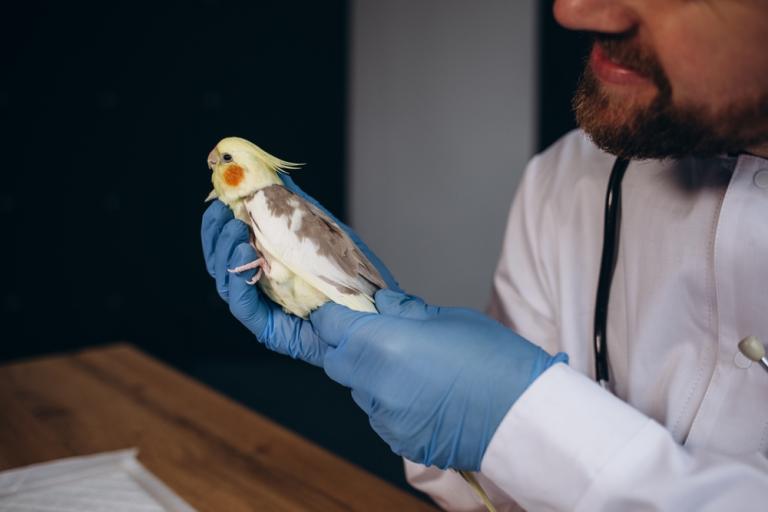The World Health Organization (WHO) has reported that an increase in psittacosis cases has been recorded in Europe in 2023 and early 2024, leading to the deaths of five people. Although the WHO “based on available information, evaluates the risk posed by this event as low,” it is important to know its risks to humans and how we can avoid them.
Table of Contents
- What is psittacosis or parrot fever, causes and how it is transmitted
- Symptoms of parrot fever and how it is treated
- Symptoms of psittacosis in birds
- Symptoms of human psittacosis
- How parrot fever is treated
- Tips to prevent infections or outbreaks of psittacosis
- Latest outbreaks of psittacosis detected in European countries
What is psittacosis or parrot fever, causes and how it is transmitted
Psittacosis or parrot fever is an infectious disease caused by a bacteria that affects numerous species of domestic and wild birds, but can also be transmitted to humans. In fact, it is considered an occupational zoonosis because people who work in contact with infected animals are at risk of contracting the disease.
Avian chlamydiosis is known as psittacosis or ornithosis depending on the type of birds affected (more than 450 susceptible species have been identified). Psittacosis is more common and affects psittacines such as parrots, parakeets, macaws, lovebirds…, and columbiformes (pigeons, doves…). The bacteria responsible for the infection is Chlamydia psittaci, which has also been found in several species of mammals, including dogs, cats, horses, ruminants and pigs, and in reptiles, although it is birds that most frequently cause human psittacosis. , which is a notifiable disease.
The infection can be transmitted to humans who come into contact with infected birds or their contaminated environment. This is the case, for example, of those who work on poultry farms or with pets or ornithologists. Transmission can occur through the air by inhaling aerosols from oral secretions or dust derived from fecal material excreted by an infected bird, by ingesting its contaminated meat, and even by receiving a peck from the sick bird. Some vectors such as fleas, lice or flies can also transmit the C. psittaci bacteria.

Symptoms of parrot fever and how it is treated
Logically, this zoonosis does not affect birds, the main victims, and humans equally. These are the symptoms of psittacosis that can be seen in each of them:
Symptoms of psittacosis in birds
In birds, the incubation period for psittacosis ranges from three days to several weeks and symptoms can range from an asymptomatic infection to a severe illness that can lead to the death of the animal. It should be noted that many infected birds do not show obvious signs of disease and this makes the detection of psittacosis difficult and puts people who come into contact with them at risk.
Symptoms of parrot fever in birds include:
- Nasal or eye discharge.
- Shortness of breath or noisy breathing.
- Changes in stool, which may be more watery or have an abnormal green color.
- Lethargy or lack of activity.
- Loss of appetite.
- Weightloss.
- Ruffled feathers.
“The technique of choice to confirm infection is PCR on clinical samples from sick or suspicious animals (pharyngeal, cloacal swab or fecal samples).”
Symptoms of human psittacosis
In humans, psittacosis can range from mild forms to severe pneumonia that requires hospitalization of the patient. When a person contracts this infection, it usually takes between one and three weeks to experience symptoms, which can be similar to other respiratory illnesses and include:
- Fever and chills.
- General fatigue or weakness.
- Headache.
- Myalgias (muscle pain).
- Dry cough, which subsequently produces thick, greenish mucus.
- Difficulty breathing or feeling short of breath.
- Gastrointestinal problems such as nausea or diarrhea.
- Complications that lead to changes in the heart (pericarditis, endocarditis), liver (hepatomegaly) and spleen (splenomegaly).
- Abortion in the event that the affected woman is a pregnant woman.
To confirm the diagnosis of human psittacosis, a blood test is performed to look for certain types of antibodies whose presence would suggest a recent infection by Chlamydia psittaci. However, doctors usually suspect the existence of the infection in people with a history of exposure. or frequent contact with birds.
How parrot fever is treated
Early diagnosis and treatment are key to avoiding serious complications, and people with psittacosis are given tetracyclines (a group of antibiotics), orally for at least 10 days, with doxycycline or erythromycin being the most commonly prescribed. It is essential that antibiotic treatment continues until completion, even if symptoms disappear, to avoid the development of bacterial resistance. In addition, it is important to also treat infected birds to prevent new infections.
Recovery can be slow, especially in severe cases, and although with appropriate treatment most patients recover, the mortality rate can reach 30% in people with untreated severe psittacosis.

Tips to prevent infections or outbreaks of psittacosis
Continuous surveillance and preventive measures both in the management of domestic birds and in interaction with wild birds are essential to control the spread of psittacosis, since there is currently no vaccine to prevent avian chlamydiosis. Following these tips will help reduce the risk of contagion:
For professionals who work with birds and the general population:
- Wear personal protective equipment: On poultry farms, zoos, and whenever wild birds are handled, appropriate protective equipment, such as gloves and masks, should always be worn to avoid direct contact with birds and their droppings.
- Avoid potentially contaminated areas: Avoid visiting poultry farms or other areas where large populations of birds are raised or maintained, especially if disease outbreaks have been reported.
- Know the signs of psittacosis in birds and humans and seek medical attention at the first symptom or suspicion of contagion.
- Report suspected cases: If you have birds showing symptoms of illness or if you know of cases in your community, immediately inform local health authorities so they can take preventive measures and prevent the spread of the disease.
For pet bird owners:
- Rigorous hygiene: it is necessary to meticulously clean the bird cages, feeders and waterers, using gloves and a mask to avoid inhaling dust or particles that may be contaminated.
- Adequate ventilation: Make sure the area where the birds are kept is well ventilated to reduce the buildup of dust and potentially infected particles.
- Quarantine for new birds: Before introducing new birds, quarantine them in a separate area for at least 30 days to watch for possible disease symptoms.
- Be careful when handling sick birds: If you suspect a bird is sick, minimize direct contact and consult a veterinarian as soon as possible. Use personal protective equipment such as gloves and a mask when handling it.
- Feeding and care: Provide your birds with a balanced diet and ensure careful handling to avoid stress, as this can make them more vulnerable to disease.
Latest outbreaks of psittacosis detected in European countries
Last February, Austria, Denmark, Germany, Sweden and the Netherlands reported through the European Union’s Early Warning and Response System (EWS) that there had been an increase in psittacosis cases observed in 2023 and early 2024. These countries have begun detailed epidemiological studies in order to track possible outbreaks and clusters of infections. The initiative includes the analysis of samples from wild birds, tested for bird flu, to determine how widespread the presence of Chlamydia psittaci is among them.
Evolution of the situation in each of these countries, according to data provided by the WHO:
- Denmark: A notable increase in psittacosis cases has been observed from late 2023 to mid-January 2024. On February 27, 2024, 23 cases of C. psittaci infection were confirmed through RT-PCR testing. Most of these cases were concentrated in three regions: Northern Denmark, Zealand and the capital, and 17 people (74%) required hospitalization. Of these, 15 developed pneumonia and four unfortunately lost their lives.
- The Netherlands has seen a growth in confirmed diagnoses of the disease since the end of December 2023, with 21 individuals diagnosed positively for C. psittaci as of February 29, 2024, doubling the figure for the same period in previous years. No common source of infection has been identified, the average age of those affected is 67 years and the majority (76%) are men. All were hospitalized and one death was reported.
- In Austria, as of March 4, 2024, four cases of psittacosis have been reported, without any of the patients identified in 2023 or 2024 having traveled abroad or had contact with wild birds as a possible source of infection.
- Germany has also seen an increase, with five new positive diagnoses in December 2023, bringing the total to 14 confirmed cases that year. Continuing into 2024, five additional confirmed cases of the disease have been recorded as of February 20.
- In Sweden, the year 2024 began with ten cases reported in January and three more in February, a figure lower than the average number of cases reported during the same period in the last five years.













